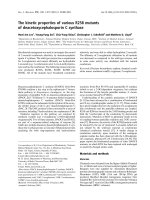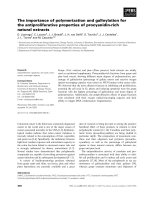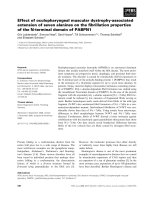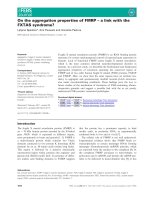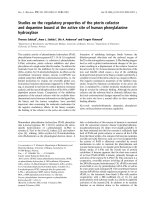The physicochemical properties of spray-dried papaya leaf powders
Bạn đang xem bản rút gọn của tài liệu. Xem và tải ngay bản đầy đủ của tài liệu tại đây (140.34 KB, 8 trang )
Int.J.Curr.Microbiol.App.Sci (2019) 8(1): 139-146
International Journal of Current Microbiology and Applied Sciences
ISSN: 2319-7706 Volume 8 Number 01 (2019)
Journal homepage:
Original Research Article
/>
The Physicochemical Properties of Spray-Dried Papaya Leaf Powders
T. Anu Babu1*, Sivala Kumar2, D.D. Smith3 and R. Lakshmipathy4
1
College of Agricultural Engineering, 2College of Food Science and Technology,
Bapatla, Andra Pradesh, India,
3
College of Food Science and Technology, Pulivendula, Andra Pradesh, India,
4
Advanced PG Centre Lam, Guntur, Andra Pradesh, India
*Corresponding author
ABSTRACT
Keywords
Spray drying, Papaya
leaf juice, Maltodextrin
concentration and Total
flavonoid content
Article Info
Accepted:
04 December 2018
Available Online:
10 January 2019
A study was conducted using laboratory spray dryer (Lab plant SD- 05) to produce spraydried papaya leaf powders using three different maltodextrin concentrations (8%, 10% &
12%) as the encapsulating agent, three feed flow rates (350 mL/h, 475 mL/h and 600
mL/h) and three different inlet temperatures (130 oC, 140 oC and 150 oC). The spray-dried
papaya leaf powders were analysed for moisture content, water activity, color, pH and total
flavonoid content. Results demonstrated that as inlet air temperature increased, the
moisture content, water activity and total flavonoid content decreased. However, there was
no significant change in the pH of the spray-dried powders for all the inlet temperatures
investigated. Colormetric analyses showed that the L*, a*, b*, hue and chroma values
changed with the inlet temperatures.
Introduction
Papaya (Carica papaya L.) belongs to the
family of Caricaceae. Papaya leaves contain
antioxidant compounds such as flavonoids.
Flavonoid has shown to play an important role
in prevention of many ill health conditions.
Flavonoid from carica papaya leaves have
significant anti-dengue activities (Senthilvel et
al., 2013). Otsuki et al., (2010) reported that
flavonoids had several functions i.e. antiinflammation, anti-tumor and anti-cancer.
Papaya leaf has many benefits. In some parts
of Asia, the young leaves of the papaya are
steamed and eaten like spinach. Fresh, green
papaya leaf is an antiseptic, while the brown,
dried papaya leaf is the best as a tonic and
blood purifier and carica papaya leaves
extracts used to treat dengue fever in patients
(Ahmad et al., 2011). Recent reports have
claimed possible beneficial effects of papaya
leaf juice in treating patients with dengue viral
infections (Yunita et al., 2012).
The papaya leaf juice by spray drying process
can produce a good quality final product with
low water activity and reduce the weight,
resulting in easy storage and transportation. It
139
Int.J.Curr.Microbiol.App.Sci (2019) 8(1): 139-146
can be easily added to other foods. Thus spray
drying is the best alternative to obtain
colorants and natural flavouring (Langrish et
al., 2009). Although spray drying of food
materials are affected by several parameters
but inlet air temperature, maltodextrin
concentration and feed flow rate are very
important parameters. Therefore, this study
was
conducted
to
examine
the
physicochemical properties of spray dried of
papaya leaf powder.
aluminium laminated polyethylene covers
under ambient conditions.
Materials and Methods
The moisture content was determined based
on AOAC method. Triplicate samples of
papaya leaf powder (3g each) were weighed
and then dried in a hot air oven at 105 oC for 3
h. The samples were removed from the oven,
cooled in a desiccator and weighed. The
drying and weighing processes were repeated
until constant weight were obtained.
Preparation of papaya leaf juice
Green papaya leaves of same maturity level
were collected from local field, leaves were
washed and sliced. The sliced leaves were
again washed with mineral water. From
papaya leaf slices, juice was extracted by
using INTEX mixer grinder. For each
experimental run, the papaya leaves (1 kg)
was blended in distilled water (250 mL), in the
ratio of 1:0.25. The juice was separated from
papaya leaf waste through filtering.
Preparation of spray dried papaya leaf
powder
Analysis of the spray-dried powder
The spray-dried powders were analyzed for
their moisture content, water activity, color pH
and total flavonoid content as described in
Sections 2.3.1–2.3.5.
Moisture content
Water activity
Measurement of water activity of papaya leaf
powder was carried out using a water activity
meter (Hygro Lab C1 bench-top meter).
Triplicate samples were analyzed and the
mean was recorded.
Color measurement
The resulting papaya leaf juice was twice
filtered using a muslin cloth to avoid blocking
of the atomizer of the spray dryer. The carrier
agent maltodextrin of 8%, 10% and 12% w/v
was added to the papaya leaf juice to increase
concentration and to reduce hygroscopicity of
the dried powder. Initially papaya leaf juice
has 5 oBrix after addition of maltodextrin
concentrations 8%, 10% and 12% w/v, the
°Brix was increased to 13%, 15% and 17%
°B, respectively. Then the concentrated
papaya leaf juice was fed in to the drying
chamber with feed flow rates of 350 mL/h,
475 mL/h, 600 mL/h and inlet air temperatures
were maintained at130 oC, 140 oC and 150 oC
temperatures. Obtained powder was stored in
The color characteristics of the spray dried
papaya leaf powder were analyzed by using
Hunter Lab Colorimeter (Color Flex EZ,
USA). The instrument was standardized with
white and black ceramic tiles before starting
the measurement. Obtained results were
expressed as Hunter color values L*, a* and
b* where L*denotes lightness and darkness,
a*denotes redness and greenness and b*
denotes yellowness and blueness. Powders
were packed in polyethylene covers and were
measured for color characteristics. The
samples were analyzed in triplicates. Color
intensity in terms of chroma was calculated by
the formula (a*2 +b*2)1/2, whereas hue angle
140
Int.J.Curr.Microbiol.App.Sci (2019) 8(1): 139-146
(Ho) was calculated by the formula Ho = arc
tan (b*/a*). The hue values of 0o, 90o, 180o
and 270o denote pure red, pure yellow, pure
green and pure blue color respectively.
pH
The pH of the papaya leaf powder sample was
determined using a pH meter (Systronics
micro pH system-362, Ahmadabad, India).
Total flavonoid content
The method used for determination of total
flavonoid content was adapted from Kamtekar
et al., (2014). Quarcetin solution (100 mg/ml)
was used to construct the standard curve. Total
flavonoid content of the spray-dried papaya
leaf powder was spectrophotometrically
determined at 510 nm and the data of total
flavonoids of papaya leaf powders were
expressed as mg of quercetin equivalents/100
g of dry mass.
Results and Discussion
Physicochemical properties of papaya leaf
powder
Table 1 shows the physicochemical properties
of the papaya leaf powder used for spray
drying. Hence the carrier agent maltodextrin
of 8%, 10% and 12% w/v was added to the
papaya leaf juice to increase concentration and
to reduce hygroscopicity of the dried powder.
After
addition
of
maltodextrin
of
concentrations 8%, 10% and 12% w/v, the
°Brix was increased to 13 %, 15% and 17%
°B, respectively. Then the concentrated
papaya leaf juice was spray dried by using
spray dryer (Lab plant SD- 05) to obtain
papaya leaf powder. Papaya leaf juice has a
bright green color as indicated by the high L*
and -a* values. Color measurement is an
important quality indicator as it reflects the
sensory attractiveness and the quality of the
powders produced in spray drying process.
Effect of maltodextrin
From the observations, there was hardly any
powder accumulated in the collector if
maltodextrin was not added in the feed. The
particles produced were very sticky and
mainly deposited onto the wall of drying
chamber and cyclone and could not be
recovered. Therefore, maltodextrin of 8%,
10% and 12% (of total feed solution) was
added to the juice prior to spray drying to
investigate its effect on the spray drying
product. Rodriguez-Hernandez et al., (2005),
Cai et al., (2000) and Desobry et al., (1997)
have reported that low DE maltodextrin has
better
nutrient
binding
properties.
Maltodextrin is also proved to be a very good
encapsulate for low molecular weight sugars
such as fructose and organic acids. Addition of
10% and 12% maltodextrin to the feed
appeared to give better yield results than
addition of 8% maltodextrin. These results
showed that maltodextrin was a useful drying
aid in spray drying of papaya leaf juice as it
improved the yield of product.
Addition of maltodextrin could increase the
total solid content in the feed and thus, reduce
the moisture content of the product. It was
suggested that maltodextrin could alter the
surface stickiness of low molecular weight
sugars such as glucose, sucrose and fructose
and organic acids, therefore, facilitated drying
and reduced the stickiness of the spray-dried
product. However, if the added maltodextrin
was more than 10%, the resulted powders lost
their attractive green color. The spray-dried
powders with the addition of 8%, 10% and
12% maltodextrin concentrations were shown
in Figure 1.
Moisture content
The results showed that the moisture content
of spray dried papaya leaf powders also
depends on the inlet air temperatures from 130
o
C to 150 oC. High inlet air temperatures often
141
Int.J.Curr.Microbiol.App.Sci (2019) 8(1): 139-146
results in decrease moisture content due to the
increased rate of heat transfer into the particles
at higher temperatures; there was a greater
driving force for moisture evaporation causing
faster water removal. Similarly, moisture
content of spray dried papaya leaf powders
increased with increase in feed flow rates from
350 mL/h to 600 mL/h. Higher flow rates
imply shorter contact time between the feed
and drying air, making the heat transfer less
efficient and thus causing lower water
evaporation.
The results also showed that the moisture
content of the spray-dried powder decreased
when the maltodextrin added increased. In a
spray drying system, the water content of the
feed has an effect on the final moisture content
of the powder produced (Abadio et al., 2004).
Addition of maltodextrin to the feed prior to
spray drying increased the total solid content
and reduced the amount of water for
evaporation. Hence, decreased the moisture
contents of the powder produced. This meant
that powders with lower moisture content
could be obtained by increasing the
percentages of maltodextrin added.
However, if the percentages of the
maltodextrin were too high, the powder
produced would have lower quality because
the nutrients from the papaya leaf juice would
be diluted. In the case of papaya leaf juice, the
green color would also loss as mentioned
previously.
Water activity
Water activity (aw) is an important index for
spray-dried powder because it can greatly
affect the shelf life of the powder produced.
Water activity of spray dried papaya leaf
powder decreased with increase in the
maltodextrin concentration from 8% to 12%.
The addition of maltodextrin could increase
the total solid content in the feed and thus
reduce the water activity of the product (Quek
et al., 2007). Similarly water activity of spray
dried papaya leaf powders increased with
increase in feed flow rates from 350 mL/h to
600 mL/h. Higher flow rates imply shorter
contact time between the feed and drying air,
making the heat transfer less efficient and thus
causing lower water evaporation. The results
also showed that water activity of spray dried
papaya leaf powders also depends on inlet air
temperatures from 130 oC to 150 oC. High
inlet air temperatures often results in decrease
water activity of spray dried papaya leaf
powders due to the faster heat transfer
between the products and drying air resulted
in more water evaporation.
pH
pH values of the papaya leaf powders slightly
increased with increase in the concentration of
maltodextrin from 8% to 12% and not affected
by inlet air temperatures and feed flow rates.
This finding was in agreement with the report
of Gonzalez-Palomres et al., (2009) who
found that pH of the Roselle extract powder
did not change with different air drying
temperatures.
Color measurement
The results of the color measurement for
powders
with
different
maltodextrin
concentrations are as shown in Table 2. L*
Value measures the lightness of the sample, a* measures the green color while +b*
measures the yellow color. Hue angle
measures the property of the color and it is the
ratio of a* and b* (hue = tan−1(b*/a*)). Chroma
indicates the color intensity or saturation
(chroma = (a*2 + b*2)1/2).
It was found that when inlet air temperature
increased, the +b* values increased but the -a*
values increased then decreased at 150 oC.
This contributed to the changes in hue angle
and chroma.
142
Int.J.Curr.Microbiol.App.Sci (2019) 8(1): 139-146
I.A.T
130
140
140
130
140
130
140
150
150
150
140
150
130
140
140
140
140
I.A.T
130
140
140
130
140
130
140
150
150
150
140
150
130
140
140
140
140
Table.1 Physicochemical properties of papaya leaf powder
MDC
FFR
Y
M.C
aw
8
475
17.8
4.79
0.34
8
350
20.1
4.48
0.32
8
600
14.12
4.95
0.34
12
475
21.08
4.33
0.34
10
475
19.72
4.48
0.33
10
350
21.98
4.39
0.32
10
475
19.73
4.49
0.34
10
600
17
4.28
0.33
10
350
22.47
4.16
0.32
8
475
18.72
4.49
0.33
10
475
19.71
4.49
0.34
12
475
21.06
4.16
0.32
10
600
16.4
4.79
0.35
12
350
24.08
4.14
0.3
12
600
19.21
4.49
0.34
10
475
19.73
4.48
0.33
10
475
19.71
4.49
0.34
pH
6.4
6.42
6.39
6.5
6.42
6.51
6.43
6.4
6.42
6.41
6.42
6.44
6.48
6.46
6.52
6.43
6.42
Table.2 Colorimetric results of the spray-dried powders
MDC
FFR
L*
a*
b*
Hue angle (o)
8
475
51.62
-10.02
35.98
-74.87
8
350
50.57
-10.98
37.02
-73.5
8
600
51.72
-10.25
36.19
-74.19
12
475
55.14
-11.42
33.78
-71.32
10
475
53.05
-11.41
36.18
-72.51
10
350
53.44
-11.3
34.81
-72.04
10
475
53.09
-11.43
36.22
-72.48
10
600
51.13
-11.56
36.12
-72.25
10
350
50.36
-12.06
37.14
-72.04
8
475
49.98
-10.8
37.95
-74.14
10
475
53
-11.45
36.27
-72.47
12
475
51.68
-12.41
35.8
-70.91
10
600
54.86
-10.86
33.69
-72.14
12
350
52.65
-12.27
36.01
-71.22
12
600
54.96
-11.54
35.01
-71.78
10
475
53.03
-11.5
36.15
-72.36
10
475
53.07
-11.41
36.19
-72.5
143
TFC
61.83
59.65
58.73
61.25
58.39
58.04
53.57
58.73
59.19
65.04
59.65
61.83
59.65
58.73
61.25
61.83
59.65
Chroma
37.34
38.61
37.61
35.65
37.93
36.59
37.98
37.92
39.04
39.45
38.03
37.88
35.39
38.04
36.86
37.93
37.94
Int.J.Curr.Microbiol.App.Sci (2019) 8(1): 139-146
Fig.1 Spray dried papaya leaf powders with different maltodextrin concentrations
a) 8% concentration of maltodextrin
b) 10% concentration of maltodextrin
c) 12% concentration of maltodextrin
Overall, the lightness of the powders reduced
and the chroma of the powders increased.
This implied that the color of the powders has
become darker at higher inlet air temperature.
One of the explanation for this phenomenon
was papaya leaf juice contains sugars which
could contribute to browning of the powders
at higher inlet temperature. As the inlet
temperature increased, the hue angles were
increased from -74.87o to -70.91o. These
figures are correspondent to the regions of
green to yellow color where 0◦ is pure green
and 90◦ is yellow. This meant that there was
decreased in green color when inlet
temperature was increased.
Total flavonoid content
obtained by adding 10% maltodextrin as a
carrier and drying agent as compared with
50% maltodextrin. Similarly, at higher feed
flow rates shorter contact between the feed
and drying air making the heat transfer less
efficient and thus total flavonoid content will
be more. Result obtained for spray dried low
fat honey based milk powder by Bansal et al.,
(2014). The results also showed that total
flavonoid content of spray dried papaya leaf
powder also depended on inlet air
temperatures. As increase in the inlet air
temperatures from 130 oC to 150 oC increased
the loss of total flavonoid content of spray
dried papaya leaf powder. Silva et al., (2011)
also reported that decrease in total flavonoid
content level during spray drying process.
Total flavonoid content decreased with
increase in the concentration of carrier agent
maltodextrin from 8% to12 %. Vidovic et al.,
(2014) reported as in the case of total
flavonoid was the highest in the powder
In conclusion, maltodextrin concentration was
an effective drying aid for spray drying of
papaya leaf juice. Addition of maltodextrin
reduced the stickiness of the products and
altered the physicochemical properties of the
144
Int.J.Curr.Microbiol.App.Sci (2019) 8(1): 139-146
spray-dried powders. The results showed that
inlet temperature has great influence on the
physicochemical properties of the spray-dried
powders. As inlet temperature increased, the
moisture content and water activity of the
powders decreased. An increase in the
lightness value of the powders was observed
with increased maltodextrin concentration.
Loss of greenness of spray dried papaya leaf
powders, resulting in low a*/b* value and
high hue angle, increased when increased
temperatures. Overall, at the inlet temperature
of 130 oC, the spray-dried powders have the
best colorimetric results, reasonably low
moisture content and water activity, as well as
good total flavonoid content. Drying the
papaya leaf juice above 150 oC has overall
lead to inferior products due to total flavonoid
content loss and changes in color. These
physicochemical properties of the powders
are very important to ensure the production of
high quality papaya leaf powders.
and Technology. 49: 1196-1202.
Cai Y.Z and Corke H. 2000. Production and
properties of spray dried Amaranthus
betacyanim pigments. J. Food Sci. 65
(6):1248–1252.
Desobry S.A, Netto F.M, Labuza T.P. 1997.
Comparison of spray drying, drumdraying and freeze-drying for bcarotene
encapsulation
and
preservation. J. Food Sci. 62 (6): 1158–
1162.
Gonzalez-Palomares, S,. Estarrón-Espinosa,
M., Gómez-leyva, J.F and Andrade
González, I. (2009). Effect of the
temperature on the spray drying of
Roselle extracts (Hibiscus sabdariffa
L.). Plant Foods for Human Nutrition.
64(1): 62-67. doi: 10.1007/111130-0080103-y.
Kamtekar, S., Keer, V and Pati, V. 2014.
Estimation of Phenolic content,
Flavonoid content, Antioxidant and
Alpha amylase Inhibitory Activity of
Marketed Polyherbal Formulation.
Journal of Applied Pharmaceutical
Science. 4 (09): 061-065.
Langrish TAG, Wang S. 2009. Crystallization
rates for amorphous sucrose and lactose
powders from spray drying: a
comparison. Drying Technology. 27:
606-614.
Otsuki, N., Dang, N.H., Kumagai, E., Kondo,
A., Iwata, S and Morimoto, C. 2010:
Aqueous extract of Carica papaya
leaves exhibits anti-tumor activity and
immunomodulatory effects. Journal of
Ethnopharmacology. 127:760–767.
Rodriguez-Hernandez. G.R,´ Gonzalez´Garcia. R, Grajales-Lagunes. A, RuizCabrera.M.A.2005. Spray-drying of
cactus pear juice (Opuntia streptacantha): effect on the physicochemical
properties of powder and reconstituted
product. Drying Technology. 23
(4):955–973.
Senthilvel, P., Lavanya, P., Kumar, K.M.,
References
Abadio, F.D.B., Domingues, A.M., Borges,
S.V and Oliveira, V.M. 2004. Physical
properties of powdered pineapple juice
(Annas comosus) juice: effect of
maltodextrin
concentration
and
atomization speed. Journal of Food
Engineering. 64 (3): 285-287.
Ahmad, N., Fazal, H., Ayaz, M., Abbasi,
B.H., Mohammad, I and Fazal, L.2011.
Dengue fever treatment with Carica
papaya leaves extracts. Asian Pacific
Journal of Tropical Biomedicine. 1(4):
330-333.
AOAC. 2000. Official Methods of Analysis
(17th edition). Washington, DC: Assoc.
of Official Analytical Chemists.
Bansal, V., Sharma, H.K and Nanda, V. 2014.
Optimisation of spray drying process
parameters for low-fat honey-based
milk powder with antioxidant activity.
International Journal of Food Science
145
Int.J.Curr.Microbiol.App.Sci (2019) 8(1): 139-146
Vidovic, S.S., Vladic, J.Z., Vaštag,.Z.G.,
Zekovic, Z.P and Popovic, L.M. 2014.
Maltodextrin as a carrier of health
benefit compounds in Satureja Montana
dry powder extract obtained by spray
drying technique. Powder Technology.
258:209–215.
Yunita, F., Hanani, E and Kristianto, J. 2012.
The effect of Carica papaya L. leaves
extract capsules on platelets count and
hematocrit level in dengue fever patient.
International Journal of Medicine of
Aromatic Plants. 2(4): 573-578.
Swetha, R., Anitha, P., Bag, S.,
Sarveswari, S., Vijayakumar, V.,
Ramaiah, S and Ambarasu, A. 2013.
Flavonoid from Carica papaya inhibits
NS2B-NS3 protease and prevents
Dengue
2
viral
assembly.
Bioinformation. 9(18): 889-895.
Silva, F.C.D., Trindade, C.S.F., Alencar,
S.M.D., Thomazini, M and Balieiro,
J.C.C.
2011.
Physicochemical
properties, antioxidant activity and
stability of spray-dried propolis.
Journal of Api Product and Api Medical
Science 3 (2): 94-100.
How to cite this article:
Anu Babu, T., Sivala Kumar, D.D. Smith and Lakshmipathy, R. 2019. The Physicochemical
Properties of Spray-Dried Papaya Leaf Powders Int.J.Curr.Microbiol.App.Sci. 8(01): 139-146.
doi: />
146




